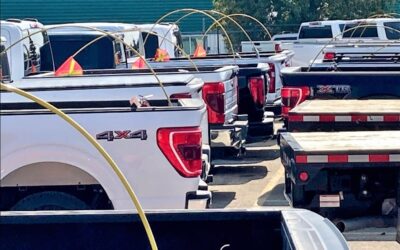Productivity Challenges Fleet Managers Face
When it comes to being a successful fleet manager, efficiency matters a lot. However, many fleet managers often find themselves surrounded by time-consuming and never-ending tasks that rarely add to the bottom line of the fleet company.These tasks also add up to become quite expensive for the company in the long run. This is why fleet managers must find all the fleet management problems that affect their productivity. They also need to find solutions that can help them become more efficient at their jobs and increase their overall productivity.
Here are 5 challenges that fleet managers face and ways to overcome these challenges:
1. Time-Consuming Administrative Tasks
Administrative tasks such as invoicing and quoting can cut into your day. These are expenses that can add up and easily contribute to various fleet management problems such as reduced productivity and reduced focus on revenue-generating tasks.
In a recent global study by TomTom on the biggest challenges faced by fleet managers, 49% of fleet managers said that at least one member of their team spends about 2 hours on quoting and invoicing. 42% said that finding and dispatching the best worker for the job was a big challenge, 43% said expense management was hard and 40% said that keeping customers informed took up most of their time.
Spending time on all of these activities means that less time is spent onrevenue-generating activities. So, how can fleet managers refocus their energies on core tasks that will be beneficial for their company?
Getting rid of time-consuming paper-based systems is surely a solid first step. A digitized workflow will enable fleet managers to complete administrative tasks in less time and reduce the risks of miscommunication and other human errors. It will also allow you to automate tasks such as sending jobs to fleet drivers, billing customers, scheduling deliveries, managing expenses, sending maintenance reminders, and performing vehicle inspections.
2. High Fuel Costs
Understandably, fuel consumption leads to huge costs for all fleet companies. Due to the increase in fuel prices in South Africa, fleet companies are struggling with massive fuel rates. Fuel management is also the responsibility of a fleet manager, who needs to find ways to save on fuel costs and consumption. The first step is to identify where the fuel is going and its consumption trends. Here are the things that you will need to check consistently:
- Track the consumption of fuel
- Identify instances of fuel overconsumption
- Monitor driver behavior and its relation to fuel consumption
- Implement digitization via vehicle telematics to cut down on fuel consumption
Moreover, fleet optimization applications can also help fleet managers create perfect routes for their fleets that enable them to reach their destinations without much delay. This will lead to less fuel consumption.
You need to implement telematics so that you can use that data to increase your productivity. You will be able to store and track all the data coming back from your fleet vehicles. Having easy access to this date will allow you to streamline your processes and kill two birds with one stone. For instance, you can use the data of driving behavior to boost driving methods.
Moreover, digitizing allows you to analyze driver behavior, which can provide you with key insights into idle time for a vehicle and how to cut down on it. This will help you reduce fuel costs since an idle vehicle also consumes unnecessary fuel.
As for dealing with mounting fuel costs, you can introduce a fuel cost reduction program to monitor and reduce fuel consumption. A written policy, which will define your expectations from the drivers, their fuel usage, and acceptable fuel practices will certainly help. Make sure to communicate this policy to all of your drivers on an annual basis. You can also add this policy and some additional fuel reduction tips to your driver training program.
3. Rising Fleet Maintenance Costs
Regular fleet vehicle maintenance is vital as it can prevent your vehicles from unexpectedly breaking down in the middle of the road. However, regular maintenance of so many vehicles can quickly become expensive. So, how can you bring more efficiency to this process so that it becomes more cost-effective in the long run?
The first step is to automate your maintenance schedule. An automated schedule will ensure that you don’t neglect any vehicle and don’t spend time tracking down the vehicles that need maintenance. You can also use digital solutions to monitor maintenance schedules, which will alert you when a vehicle shows early signs of failures so that you can act before the maintenance costs rack up.
4. Miscommunication With Fleet Drivers
It can be a bit challenging to communicate with your on-the-road fleet drivers as you can’t always reach out to them via phone or radio. This is why miscommunication is pretty common between fleet managers and their drivers and it can wreak havoc in the team’s schedule. It’s also pretty time-consuming and keeps the fleet managers from focusing on other important tasks.
This is also where digitization can help you. You can use various software and digital solutions to streamline your communication with fleet drivers that are on the go. You can use tech that spends your message to your drivers and even reads the message out to them so that they don’t get distracted while driving. Telematics will also help you have a clear understanding of what is happening on the road.
5. Delivering Accurate ETAs to Customers
Giving out inaccurate estimated times of arrival to your customers can truly impact your business’s reputation negatively. You don’t want your customers to think that you are not reliable and can’t be trusted. Today, customers want to know the exact time window on the exact date when they will revise their delivery. You simply can’t give them a rough ETA.
You can use digital tech to monitor traffic and predict an accurate ETA for your customers. You can also communicate unexpected scheduled changes to your customers via digitization so that they always remain informed about delays and any changes in the ETA.
These were the top fleet management problems that you can face as a fleet manager. Now, you need to digitize your tasks so that you can get rid of these challenges and increase your workflow productivity, save your time, and cut down on overall company expenses.
Source:
https://www.entrepreneur.com/article/333232






